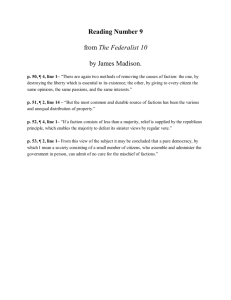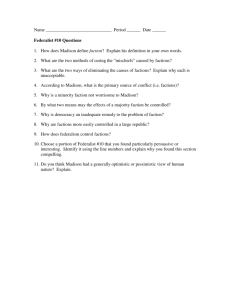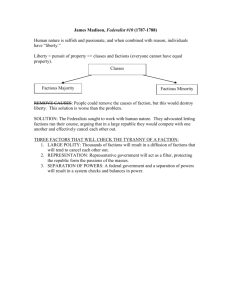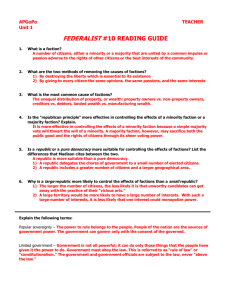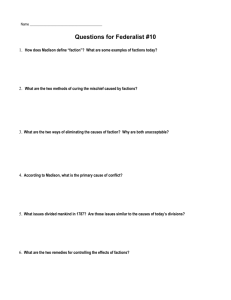In Defense of Party Factions Torun Dewan Francesco Squintani LSE
advertisement
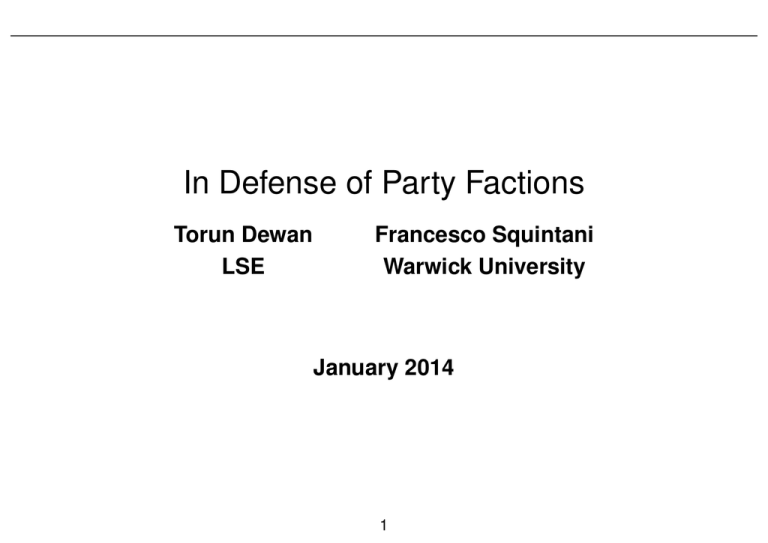
In Defense of Party Factions
Torun Dewan
LSE
Francesco Squintani
Warwick University
January 2014
1
The Model
• A set of party politicians I and a set of policies K.
• There is a given endowment of policy making authority e : K → I .
• Factions form via voluntary delegation of authority.
Delegation is repeated until it stops.
The final assignment of policy making authority is a
2
: K → I.
• Politicians obtain signals si ∈ {0, 1} about θ ∼ U [0, 1].
The signals are conditionally i.i.d.:
P r(si = 1|θ) = θ.
• Strategic communication between politicians.
Each politician i sends a message mij
∈ {0, 1} to every other politician j .
W.L.O.G. There are two strategies:
Revealing, mij (si )
= si , and babbling mij (si ) = 0.
• Platform design via final policy choices.
For each policy k , politician a(k) decides ŷk
3
∈ ℜ.
• The ex-post payoff of each player i is
ui (ŷ, θ) = −
∑
(ŷk − θ − bi )2 .
k∈K
Equilibrium
• Pure Strategy Perfect Bayesian Equilibrium (a, m, y)
• Punishment if player i fails to delegate is babbling to i.
We do not allow for complete communication shut-down as an equilibrium
punishment.
• Coordination on efficient (weighted Utilitarian) equilibrium.
4
Communication and Platform Design
• Given communication strategy m, let dj (m) be the number of informative signals of
player j, and lj (m) the number of signals equal to 1
• In equilibrium m, if policy k is assigned to politician j, he makes the decision
yk = E [θ|lj (m), dj (m)] + bj .
• The profile m is an equilibrium if and only if, when politician i is truthful to j ,
1
|bi − bj | ≤
2 [dj (m) + 2]
• The expected utility of any player i for a policy k assigned to a politician j is
1
Eui (j, m) = −
− (bi − bj )2
6 (dj (m) + 2)
5
Faction Formation
• Politicians delegate authoritty until no further delegation can take place
• In principle complicated factional network can arise.
• Define factional network as a directed weighted graph f (e, a).
fij (e, a) = |{k ∈ K : e (k) = i, a (k) = j}| is the number of decisions k that
are initially endowed to politician i and transferred to j .
• In principle complicated factional network can arise.
• In equilibrium only disjoint factions with unique leaders.
6
Proposition 1. In any equilibrium (a, m, y) party I is divided in a collection C of
disjoint factions. For any faction F, all politicians j in F delegate all decisions to a
unique leader l(F ), who does not delegate decisions further.
• Given m, i delegates only to a more informed party member.
• Expected utility depends only on identity of decision-maker,
• If i delegates to j then she transfers all policies endowed to her.
• For any faction leader l(F ), define dl(F ) (C, L) as the maximum information held by
l(F ) in equilibrium.
• For any other player j, let dj (C, L) = 1.
7
Proposition 2. In any Pareto-undominated equilibrium (a, m, y) , the factional
structure C
= {F1 , ..., FN } with leaders L = {l (F1 ) , ..., l (FN )} is such that for
any faction F and i ∈ F, j ∈ I
(
)2
1
1
2
) + bi − bl(F )
+ (bi − bj ) ≥ (
(1)
6 (dj (C, L) + 2)
6 dl(F ) (C, L) + 2
Proposition 3. The factions that form in any Pareto-undominated equilibrium are
ideologically connected: If politicians i and j belong to the same faction F , then so
does any politician k whose bias bk is between bi and bj .
8
• Propositions 2 and 3 recover definitions and stylized facts:
1. “A structured group within a political party which seeks at a minimum to control
authoritative decision-making positions of the party.” (Zuckermann 1975)
2. “Any intra-party combination, clique, or grouping whose members share a sense of
common identity and common purpose and are organized to act collectively-as a
distinct bloc within the party- to achieve their goals.”(Zariski 1960)
9
The Equidistant Bias Case
• We study a specialized model in which the ideological distance of bias neighbors is
constant across politicians.
• There is an odd number of politicians I ≥ 5.
• Each politician i is endowed a single policy k , so that K = I, and e(k) = k.
• For any i = 1, ...I, the bias of politician i is bi = iβ :
the ideological distance between ideological neighbors is β.
10
Example 1: Equidistant Bias with Seven Players, I
= 7.
√ 1
• Suppose that the bias difference is sufficiently small, β ≤ 5 45 .
• Then, the median politician 4 is sufficiently informed,
and all politicians are willing to delegate decision to him.
• Unifying the party under a median leader is the optimal configuration.
√ 1
• As |b3 − b4 | = |b5 − b4 | = β ≤ 5 45 < 1/10, d4 (m) ≥ 3 in an equilibrium m.
In fact, by Lemma 1, player 3 can inform 4 truthfully in equilibrium if
|b3 − b4 | ≤
1
.
2[d4 (m)+2]
• By Proposition 2, all players delegate to 4 if 1 delegate to 4.
This occurs if 6(d 1+2)
1
≥
which is satisfied when β
1
6(d4 (m)+2)
≤
1
45
+ (b1 − b4 )2 , or
√
5 and d4 (m) ≥ 4.
11
1
18
≥
1
6(d4 (m)+2)
+ 9β 2 ,
√
• Suppose we increase β so that
45 < β ≤
1
5
1
30
√
5.
• Using Lemma 1, now d3 = d4 = d5 = 3.
√
1
• Using Proposition 2, because β > 5 45 now, extremists 1 and 7 do not delegate to
4, in equilibrium.
√
1
• But, because β ≤ 30 5, 1 and 7 would delegate to 3 and 5 respectively.
• Optimal configuration is C that consists of F1 = {1, 2, 3}, F2 = {4},
F3 = {5, 6, 7}, with leaders l(F1 ) = 3 and l(F3 ) = 5 and F2 = {4}.
• Note that the median politician is isolated.
12
• Suppose that β is larger still, specifically
1
30
√
5<β≤
1
12
√
2
• By Equation 1, extremists 1 and 7 do not delegate to 3, 4 or 5.
• But 1 and 7 would delegate to 2 and 6 respectively.
• The optimal configuration is F1 = {1, 2}, F2 = {3, 4, 5}, F3 = {6, 7},
with l(F1 ) = 2, l(F3 ) = 6 and l(F2 ) = 4.
• Finally, if β >
1
12
√
2, then by Lemma 1, di = 1 for all i = 1, ..., n.
• So, no factions form, and each politician makes one decision.
13
Tying in the Extremists
• Leaders are separated by “ideological steps” of length β .
• In the optimal equilibrium, extreme politicians join faction with moderate leaders, and
this improves welfare.
√ 1
E.g., when β ≤ 5 45 , extremists 1 and 7 join factions led by 3 and 5.
• But this prevents moderates from joining factions led by even more moderate leaders.
√ 1
When β ≤ 5 45 , 2 and 6 cannot join the faction led by 4, in the optimal equilibrium.
• The first order concern is to avoid that extremists exert influence on party platform.
• So, it is better that the extremists join factions led by moderates,
rather than moderates join factions led by even more moderate leaders.
14
• This logic defines an iterative procedure to calculate (C, L)
– Begin with the most extreme politician
– Bind her in the most moderate faction possible
– Continue iteratively
– The remaining politicians form faction lead by median.
Proposition 4. Suppose that there are an odd number I
≥ 5 of politicians, and that
ideological neighbors are at ideological distance β . The welfare maximizing
equilibrium factional structure is characterized as follows:
1. Each leader l’s equilibrium information equals d (β)
= min{I, d∗ } whenever
g(d∗ + 1) < β ≤ g (d∗ ) , where the function g (·) is defined as
g (d) = (2 · ⌈(d − 1)/2⌉ · (d + 2))−1 for any integer d. The leader of each
faction is always its most moderate politician.
15
⌊ √
2. Letting q (β)
=
1
β
d(β)−1
18(d(β)+2)
⌋
, there are G = 2 ·
⌊
I−1
2(q(β)+1)
⌋
+ 1 factions,
symmetrically arranged around the median politician m
= (I + 1)/2. All factions
are of size q (β) + 1 but the one containing the median politician m, which is of
size M = I − (G − 1)(q(β) + 1).
• This result provides a novel rationale for factionalization:
Factions tie in extremists, and prevent that they extert direct influence within the party.
16
Three Ideological Groups
• Suppose that K = I , again, and that there are three ideological groups: left, center
and right,
• The group sizes nL , nR , and nC , with ni ≥ 3.
• The groups’ ideologies −bL , 0, and bR .
• The party welfare induced by assigning an action k to a leader of group j is:
∑
nL + nR + nC
2
ni (bi − bj ) −
Wj = −
.
6 (dj + 2)
i=L,C,R
17
Results
• Suppose small biases and/or large groups.
– Then, the party is united under dominant faction.
• Suppose large biases bL and bR and/or small groups.
– Then the party remains divided in three ideological tendencies
• Suppose bL large and bR small relative to the size of groups.
– Then a faction of the center-left forms and the right is isolated.
– The leader (of the center-left faction) is either a centrist or a leftist,
depending on whether WC
> WL , or WC < WL .
• Interchanging L with R we obtain a center-right faction.
18
Welfare Analysis
• Benchmark 1: Factionalized-vs-Centralized Party
Decisions are either shared between faction leaders
Or centralized to a moderate leader
Proposition 4 For generic ideologies b, the party’s welfare is weakly larger if the
party is united under the leadership of the welfare-maximizing politician than in any
equilibrium of our factionalization game.
• Moderate leadership always desirable,
• But as we have seen, it may not always sustainable.
• Then factions may offer a second best solution.
19
• Benchmark 2: Factionalized-vs-Nonfactionalized party
Decisions are shared between faction leaders
Or politician exercises own judgement.
• With equidistant bias neighbors, factions are welfare enhancing.
• This is also the case with a symmetric, single-peaked bias distribution.
• Usually this is also the case with three ideological groups.
• But not always the case, when an extremist (e.g., a leftist) leads a factiion that
includes centrists (say, a center-left faction).
20
Example 2. Suppose three ideologies, and a center-left faction led by a leftist leader.
• The leftists gain from the centrists delegating to a leftist leader.
• Because WL > WC , centrists are better off under the leadership of a leftist.
• But the center-left faction may be very detrimental to rightwing politicians.
• As a result, aggregate welfare can be lower than without factions.
• For example, suppose that nC = 3, nR = 3, nL = 6, bL = 1/10.
– If 1/12
– If bR
< bR < 1/4, then factionalization is beneficial to the party.
> 1/4, then aggregate party welfare is higher without factions.
21
Open-vs-Closed Debate
• So far, we presumed open debate: all players can communicate to all.
• Suppose politicians can communicate only within factions, and return to example 1.
Example 1 (revisited) Suppose there are seven politicians, I
= 7 with K = I and
e(k) = k . Suppose the ideological distance between bias neighbors is fixed and
equal to β : bi = iβ for i = 1, ...I..
– Consider again the intermediate bias case with
√
5
45
<β≤
√
5
.
30
– Under open communication, the optimal configuration is {1, 2, 3}, {4}, {5, 6, 7}.
– But with communication closed within factions, it is {1, 2, 3, 4}, {5, 6, 7}, with
leaders 3 and 5 (or {1, 2, 3} and {4, 5, 6, 7} with leaders 3 and 5.
22
• There may be fewer and larger factions when debate is closed within factions.
• The reason is that closed debate makes factionalization more costly to the party.
• So, it becomes beneficial that {4} is merged into faction {1, 2, 3}.
• With closed debate, the median politician 4 is uninformed if he remains alone.
• He prefers to join the faction {1, 2, 3} led by 3, and this benefits the whole party.
23
Literature
• Factions of interest: Persico, Rodrigues, Silverman (2011)
• Factions and party leadership: Caillaud,Tirole (1999), Castanheira, Crutzen and
Sahuguet (2004,2010)
• Leadership: Dewan, Myatt (2007, 2008)
• Party formation: Krehbiel (1993), Levy (2004), Morelli (2004), Patty (2008), Eguia
(2008, 2010), Diermeier and Vlaicu (2011), ...
24
